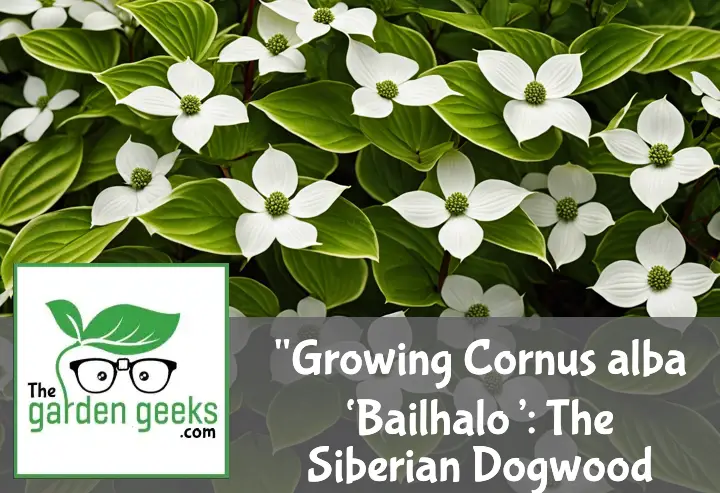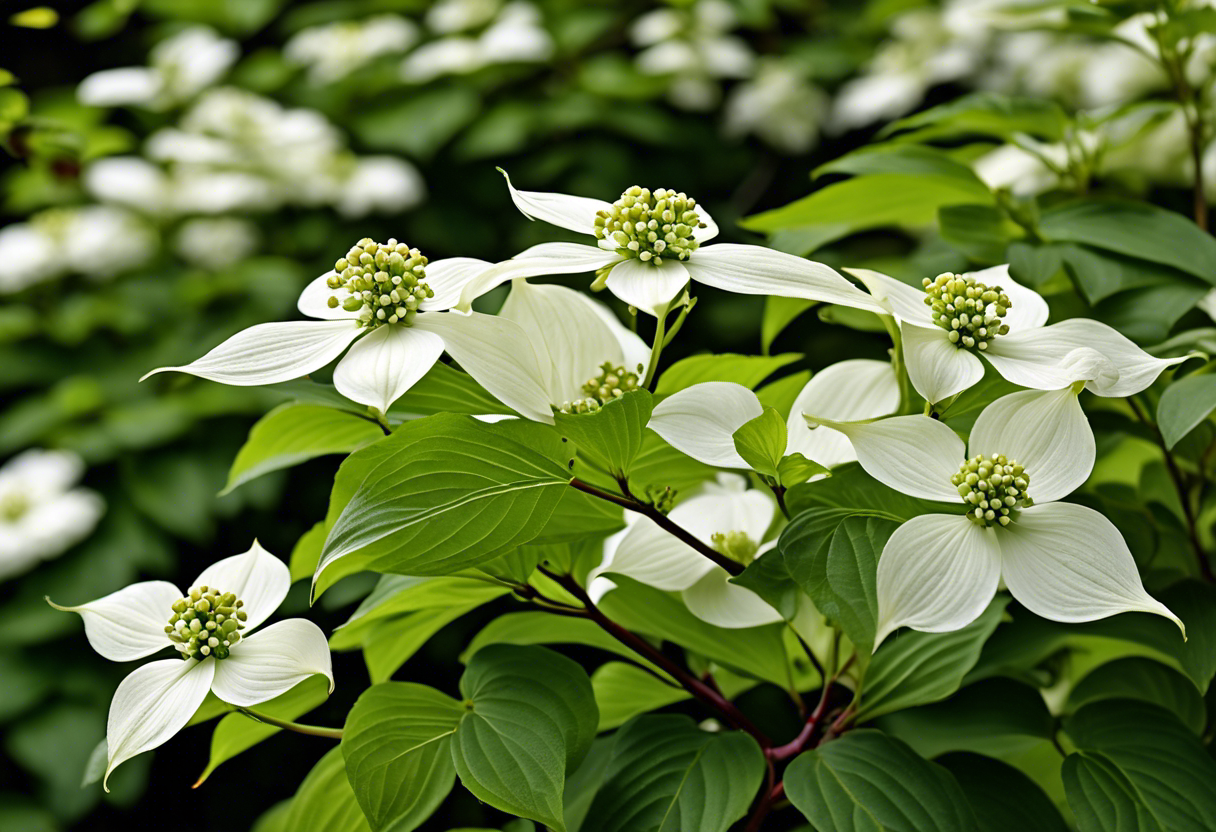Hello there, green thumbs! Ever heard of the Siberian Dogwood? No? Well, today’s your lucky day! We’re diving into the wonderful world of Growing Cornus alba ‘Bailhalo’. It’s a bit of a mouthful, I know, but trust me – this plant is worth every syllable.
This striking shrub is not just another pretty face in the garden. It’s got personality and charm that can turn any dull space into an enchanting oasis. So strap in, folks! We’re about to embark on a gardening adventure like no other. Keep reading about Growing Cornus alba ‘Bailhalo’: The Siberian Dogwood Guide.
Key Takeaways
- Cornus alba ‘Bailhalo’, also known as Siberian Dogwood, is a hardy shrub that thrives in USDA zones 2-7.
- It prefers full sun to partial shade and well-drained soil.
- The plant is known for its variegated leaves and bright red stems in winter.
- Regular pruning in late winter or early spring promotes vibrant stem color.
- It’s resistant to most pests and diseases but can suffer from leaf spot and twig blights.
- Propagation is typically done through hardwood cuttings.
What is Cornus alba ‘Bailhalo’?
Well, let me tell you about this beauty! Cornus alba ‘Bailhalo’, also known as the Siberian Dogwood, is a real showstopper among dogwood species. It’s one of those ornamental shrubs that can turn any garden into a head-turner.
Origin and Description
This gem hails from Siberia, hence the name. It’s a tough cookie, adapted to survive in harsh climates. The origin of Siberian Dogwood is reflected in its sturdy nature and resilience.
Now, let’s talk about its looks. The physical attributes of Cornus alba ‘Bailhalo’ are nothing short of stunning. This plant sports variegated leaves with creamy white edges that contrast beautifully against its green center.
But wait till winter comes around! That’s when it truly shines with its bright red stems standing stark against the snowy backdrop. Talk about a pop of color in your winter garden!
Unique Features of Siberian Dogwood
What makes this variety stand out among other dogwoods? Well, for starters, it has an incredibly vibrant winter display thanks to those fiery red stems we talked about earlier.
The unique features of Cornus alba ‘Bailhalo’ don’t stop there though. Unlike many other dogwoods, this one flaunts variegated foliage which adds an extra layer of visual interest throughout the year.
And did I mention it’s low maintenance? Yep! This plant doesn’t demand much attention but still manages to steal the show every time! Now isn’t that what we all want from our garden plants?
Why Grow Cornus alba ‘Bailhalo’?
So, you’re thinking about growing Cornus alba ‘Bailhalo’, eh? Well, let me tell you, it’s not just about having a green thumb. This Siberian Dogwood has some serious ornamental benefits and environmental advantages that make it a top pick for any garden.
Ornamental Benefits
First off, let’s talk about the aesthetic appeal of this beauty. The color of Cornus alba ‘Bailhalo’ is something to behold. It sports a vibrant mix of red stems in winter and variegated leaves in summer.
But wait, there’s more! Its plant shape adds another layer to its ornamental value. With its compact form and dense branching, it creates an eye-catching visual impact that’s hard to ignore.
Environmental Advantages
Now onto the eco-friendly part – the environmental benefits of growing this gem. One major perk is soil improvement. You see, like many plants, Cornus alba ‘Bailhalo’ helps prevent soil erosion and improves its quality over time.
And let’s not forget about our furry and feathered friends! This plant is a wildlife magnet, attracting all sorts of critters from birds to bees with its berries and flowers. So if you’re into sustainable gardening and want to give your local ecosystem a boost, this Siberian Dogwood is your go-to guy!
How to Plant Cornus alba ‘Bailhalo’?
When it comes to planting Siberian Dogwood, there are a few key steps you need to follow. From choosing the right location, preparing the soil, and the actual planting process, growing Cornus alba ‘Bailhalo’ can be an exciting gardening adventure.
Choosing the Right Location
First things first, let’s talk about finding that perfect spot for your new plant. The ideal location for Siberian Dogwood is somewhere with plenty of sunlight. These plants love a good dose of daily sunshine but they’re not too picky – partial shade will do just fine too.
The next thing to consider is space. You see, Cornus alba ‘Bailhalo’ likes its elbow room. So make sure you’ve got enough space for this beauty to spread out and show off its stunning white bark and vibrant red stems.
Soil Preparation
Now onto soil prep! When it comes to preparing soil for Siberian Dogwood, there are a few things you need to keep in mind. First up is pH level. Your Cornus alba ‘Bailhalo’ prefers slightly acidic to neutral soil, so aim for a pH between 6.0 and 7.0.
Next up on our soil prep checklist is nutrient content. This plant isn’t too fussy but does appreciate a well-fertilized patch of earth. Lastly, don’t forget about drainage! Good drainage is essential for preventing root rot and keeping your Siberian Dogwood happy and healthy.
Planting Process
Alrighty then, we’ve chosen our spot and prepped our soil – now it’s time for the fun part: planting! When it comes down to the nitty-gritty of how to plant Cornus alba ‘Bailhalo’, start by digging a hole twice as wide and just as deep as the root ball.
Pop your plant in, making sure it’s level with the ground. Fill the hole back up, firming gently around the base. And voila! You’ve planted your Siberian Dogwood. But wait, there’s one last step – watering. Give your new plant a good drink to help it settle in. And there you have it, folks! Your planting Cornus alba guide in a nutshell.
Caring for Your Siberian Dogwood
Now that you’re knee-deep in the world of Growing Cornus alba ‘Bailhalo’, let’s talk about some essential care requirements. We’ll cover watering, fertilization, and pruning to keep your Siberian Dogwood healthy and thriving.
Watering Requirements
First things first, hydration. Watering Cornus alba ‘Bailhalo’ is a bit like Goldilocks – not too much, not too little, but just right. The optimal moisture levels for dogwoods depend on several factors.
Your local climate plays a big role in watering frequency for dogwoods. If you live somewhere hot and dry, you’ll need to water more frequently than if you’re in a cooler, wetter area. Soil type also matters; sandy soils drain faster than clay ones.
Fertilization Needs
Next up: food! Fertilizing Cornus alba ‘Bailhalo’ is crucial for its growth. The best fertilizer for dogwoods is one rich in nitrogen, phosphorus, and potassium. These nutrients are key to the plant’s health.
The nutrient needs of Siberian Dogwoods vary throughout the year. In spring and summer when growth is active, they need more nutrients than during fall and winter when they’re dormant. So remember to adjust your fertilizing schedule accordingly!
Pruning Techniques
Last but not least: grooming! Pruning Cornus alba ‘Bailhalo’ helps maintain its shape and promotes new growth. Trimming techniques for dogwoods aren’t complicated – it’s all about timing.
Seasonal pruning guide for dogwoods suggests late winter or early spring as the best time to prune. This way, you remove old growth before new shoots appear. But remember: always use sharp tools to avoid damaging your plant!
Troubleshooting Common Problems
When growing Cornus alba ‘Bailhalo’, you might encounter a few hiccups. But hey, don’t sweat it! We’re here to help you navigate through these common Siberian Dogwood problems.
Identifying Diseases and Pests
First things first, let’s talk about identifying those pesky diseases and pests. The key to keeping your Cornus alba ‘Bailhalo’ healthy is early detection of any issues.
Look out for signs of plant illness like yellowing leaves or stunted growth. These could indicate a disease or pest problem. Also, keep an eye out for tiny critters on the leaves or stem – that’s a telltale sign of Siberian Dogwood pests.
Effective Treatment Methods
Now that we’ve identified the problem, let’s move on to treating it. There are several effective methods for treating plant diseases and ensuring your Cornus alba ‘Bailhalo’ stays in tip-top shape.
For diseases, consider using organic fungicides or bactericides depending on the issue at hand. For pests, natural pest control methods like introducing beneficial insects can be quite effective.
Remember folks, growing Cornus alba ‘Bailhalo’ isn’t always smooth sailing but with these Siberian Dogwood care tips, you’ll have a healthy and vibrant plant in no time!
Propagating Cornus alba ‘Bailhalo’
When it comes to propagation of Siberian Dogwood, there are two main methods you can use. These are seed propagation and cuttings propagation. Both methods have their own steps and techniques, which we’ll discuss in detail.
Seed Propagation
Growing Cornus alba ‘Bailhalo’ from seeds is a fun project for any gardener. The best time to plant Bailhalo seeds is during the late winter or early spring months.
To prepare the seeds, soak them in lukewarm water overnight before planting. This helps to soften the hard outer shell and speed up germination.
Once planted, caring for Bailhalo seedlings involves regular watering and protection from harsh weather conditions until they’re strong enough to survive on their own.
Cuttings Propagation
The other method of Siberian Dogwood propagation is through cuttings. The best time for cutting propagation of Cornus alba is during the summer when the plant’s growth is most vigorous.
Taking cuttings from Siberian Dogwood involves selecting a healthy branch and making a clean cut below a leaf node. After that, remove all but the top pair of leaves from your cutting.
To encourage root growth in Bailhalo cuttings, dip the cut end into rooting hormone before planting it in a pot filled with well-draining soil mix. Keep the soil moist but not soggy, and place your pot in a location with bright indirect light until roots develop.
To Wrap Up
Growing Cornus alba ‘Bailhalo’ is like parenting a goldfish – it needs attention, but not too much. Just the right amount of sun, water and pruning will keep it happy. More on Growing Cornus alba ‘Bailhalo’.
So why wait? Get your green thumbs ready and add this Siberian beauty to your garden. Remember, a thriving ‘Bailhalo’ is a sight for sore eyes!





